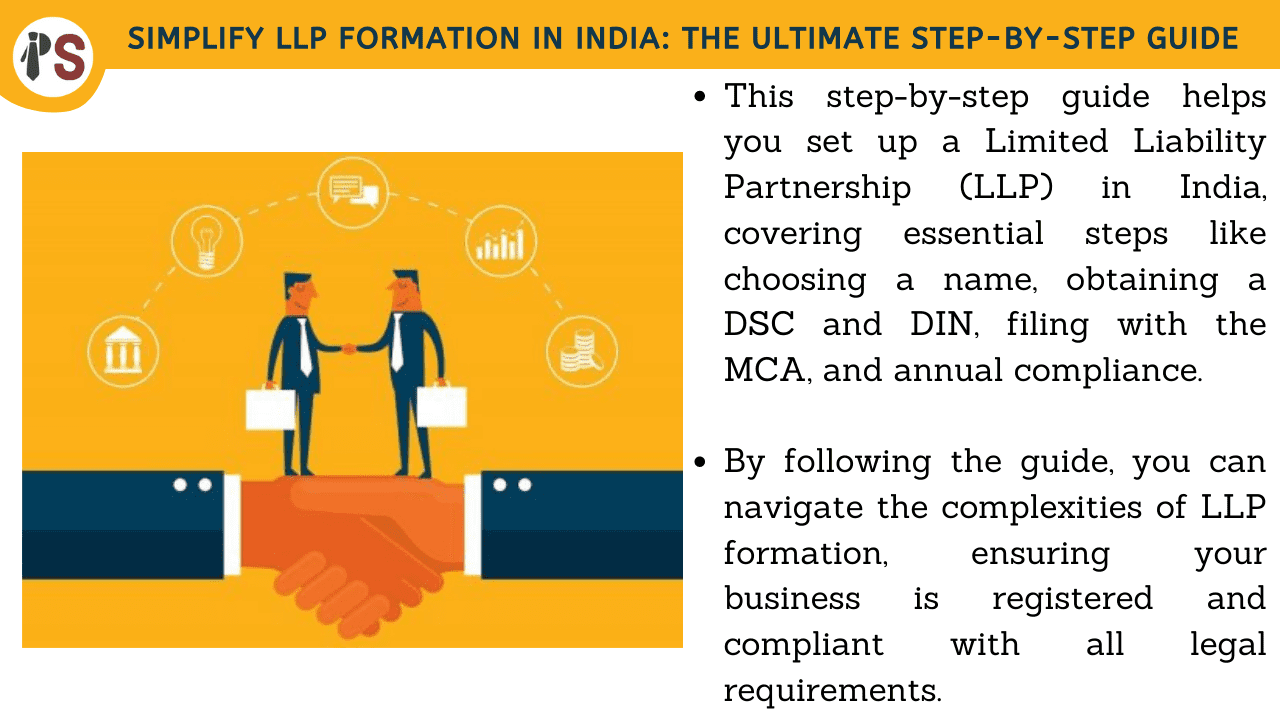
Setting up a Limited Liability Partnership (LLP) can offer numerous benefits for your business, such as limited liability protection and tax advantages. In this step-by-step guide, we will walk you through the process of establishing an LLP in India. If you're looking for professional assistance with this process, check out our Limited Liability Partnership registration service.
The first step in setting up an LLP is choosing a unique name that represents your business. Make sure the name is not identical or too similar to an existing LLP, company, or trademark.
Before filing any online forms with the Ministry of Corporate Affairs (MCA), you'll need a Digital Signature Certificate (DSC) for the designated partners. You can obtain a DSC from a government-authorized certifying agency.
Each designated partner in the LLP must have a Director Identification Number (DIN). To obtain a DIN, submit Form DIR-3 along with the required documents, such as identity and address proof, to the MCA.
To reserve your chosen LLP name, file Form RUN-LLP (Reserve Unique Name - Limited Liability Partnership) with the MCA. You can submit up to two name choices in the form, and the MCA will approve one of them if it meets the naming guidelines.
The LLP Agreement is a crucial document that outlines the rights, duties, and responsibilities of the partners. It also covers aspects such as profit-sharing, management, and dispute resolution. You should draft this agreement carefully, preferably with the help of a legal expert.
Once you have reserved the LLP name and drafted the LLP Agreement, you can proceed to file the following forms with the MCA:
Form FiLLiP (Form for Incorporation of Limited Liability Partnership): This form contains basic details about the LLP, such as its name, address, and business activity. You will also need to provide details about the designated partners and their contributions.
Form 3 (Information with regard to the LLP Agreement): File this form within 30 days of incorporation to provide the MCA with details about your LLP Agreement.
Ensure you attach the necessary documents and pay the prescribed fees while submitting these forms.
After the MCA reviews and approves your incorporation forms, they will issue a Certificate of Incorporation. This certificate serves as proof that your LLP is legally registered and can commence its business activities.
As a registered LLP, you'll need to apply for a Permanent Account Number (PAN) and a Tax Deduction Account Number (TAN) for tax-related purposes. You can apply for both online through the Income Tax Department's website.
Finally, open a bank account in the name of your LLP to manage its financial transactions. You will need to provide the bank with your LLP's Certificate of Incorporation, LLP Agreement, PAN, and other relevant documents.
By following these steps, you can successfully set up a Limited Liability Partnership in India. Remember that ongoing compliance, such as filing annual returns and maintaining proper accounts, is essential to keep your LLP in good standing. For professional help with setting up and managing your LLP, consider using our Limited Liability Partnership registration service.
If your LLP's annual turnover exceeds the specified threshold or if your business is involved in inter-state transactions, you must register for Goods and Services Tax (GST). You can apply for GST registration online through the GST portal.
Depending on the nature of your business and the number of employees, you may need to register for various labour and employment laws, such as the Employees' Provident Fund (EPF), the Employees' State Insurance (ESI), and the Professional Tax. Ensure you comply with these regulations to avoid penalties and maintain a healthy work environment.
As an LLP, you are legally required to maintain proper books of accounts that accurately reflect your business's financial transactions. Ensure you follow the accounting standards and practices prescribed by the Institute of Chartered Accountants of India (ICAI).
LLPs must file annual returns and statements with the MCA to keep their registration valid. These filings include:
Form 8 (Statement of Account and Solvency): This form contains your LLP's financial statements and must be filed within 30 days from the end of six months of the financial year.
Form 11 (Annual Return of Limited Liability Partnership): This form provides information about the partners and their contributions and must be filed within 60 days of the close of the financial year.
In addition to these filings, ensure you comply with all tax filing requirements, such as filing Income Tax Returns and GST Returns.
By following these steps and ensuring ongoing compliance, you can successfully set up and maintain a Limited Liability Partnership in India. For professional assistance with the registration and management of your LLP, visit our Limited Liability Partnership registration service page.
At Professional Saathi, we offer a range of business consultancy services that help businesses improve their performance, achieve growth, and overcome challenges.
Copyright 2026 © Created By KTPG PROFESSIONAL SAATHI CORPORATE CONSULTANT PRIVATE LIMITED, All Rights Reserved.
Leave Your Comment